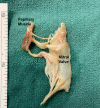Acute mitral valve regurgitation secondary to papillary muscle rupture due to infective endocarditis
- PMID: 35804449
- PMCID: PMC9270734
- DOI: 10.1186/s13019-022-01854-2
Acute mitral valve regurgitation secondary to papillary muscle rupture due to infective endocarditis
Abstract
Background: Papillary muscle rupture due to infective endocarditis is a rare event and proper management of this condition has not been described in the literature. Our case aims to shed light on treatment strategies for these patients using the current guidelines.
Case presentation: This case presents a 58-year-old male with acute heart failure secondary to papillary muscle rupture. He underwent an en bloc resection of his mitral valve with a bioprosthetic valve replacement. Specimen pathology later showed necrotic papillary muscle due to infective endocarditis. The patient was further treated with antibiotic therapy. He recovered well post-operatively and continued to do well after discharge.
Conclusion: In patients who present with papillary muscle rupture secondary to infective endocarditis, clinical symptoms should drive the treatment strategy. Despite the etiology, early mitral valve surgery remains treatment of choice for patients who have papillary muscle rupture leading to acute heart failure. Culture-guided prolonged antibiotic treatment is vital in this category of patients, especially those who have a prosthetic valve implanted.
Keywords: Case report; Infective endocarditis; Mitral regurgitation; Papillary muscle rupture.
© 2022. The Author(s).
Conflict of interest statement
The authors declare that they have no competing interests.
Figures



References
-
- Baddour LM, Wilson WR, Bayer AS, Fowler VG Jr, Tleyjeh IM, Rybak MJ, Barsic B, Lockhart PB, Gewitz MH, Levison ME, Bolger AF, Steckelberg JM, Baltimore RS, Fink AM, O'Gara P, Taubert KA. American Heart Association Committee on Rheumatic Fever, Endocarditis, and Kawasaki Disease of the Council on Cardiovascular Disease in the Young, Council on Clinical Cardiology, Council on Cardiovascular Surgery and Anesthesia, and Stroke Council. Infective endocarditis in adults: diagnosis, antimicrobial therapy, and management of complications: a scientific statement for healthcare professionals from the American Heart Association. Circulation. 2015;132(15):1435–86. 10.1161/CIR.0000000000000296. Epub 2015 Sep 15. Erratum in: Circulation. 2015 Oct 27;132(17):e215. Erratum in: Circulation. 2016 Aug 23;134(8):e113. Erratum in: Circulation. 2018;138(5):e78–9. - PubMed
-
- Nishimura RA, Otto CM, Bonow RO, Carabello BA, Erwin JP, 3rd, Fleisher LA, Jneid H, Mack MJ, McLeod CJ, O'Gara PT, Rigolin VH, Sundt TM, 3rd, Thompson A. 2017 AHA/ACC focused update of the 2014 AHA/ACC guideline for the management of patients with valvular heart disease: a report of the American College of Cardiology/American Heart Association task force on clinical practice guidelines. J Am Coll Cardiol. 2017;70(2):252–289. doi: 10.1016/j.jacc.2017.03.011. - DOI - PubMed
-
- Baumgartner H, Falk V, Bax JJ, De Bonis M, Hamm C, Holm PJ, Iung B, Lancellotti P, Lansac E, Rodriguez Muñoz D, Rosenhek R, Sjögren J, Tornos Mas P, Vahanian A, Walther T, Wendler O, Windecker S, Zamorano JL, ESC Scientific Document Group ESC/EACTS Guidelines for the management of valvular heart disease. Eur Heart J. 2017;38(36):2739–2791. doi: 10.1093/eurheartj/ehx391. - DOI - PubMed
Publication types
MeSH terms
LinkOut - more resources
Full Text Sources
Medical
Research Materials

